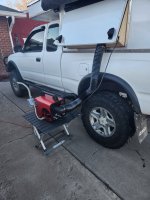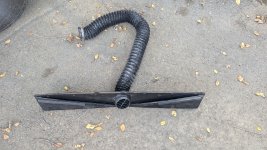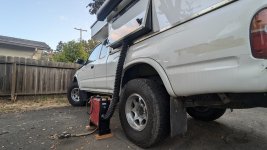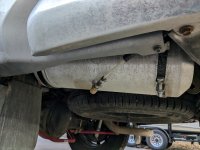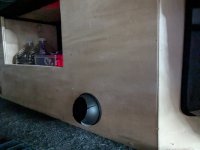I'm one of those guys who is running a diesel heater on the outside of their camper, and here are some of my own experiences:
- I am in a completely uninsulated (nothing more than what the camper had from the manufacturer) Alu-Cab Canopy Camper on my '21 Tacoma.
- I have a 5kw Vevor unit mounted underneath the truck bed, behind the OEM hitch basically. Fuel tank is located between the camper and cab, outside as well.
- Unit is always 'ready-to-go', as in it doesn't sit on a table or the ground. It always has power, and the fuel lines are permanently installed. Thermostat is mounted inside of the camper in a place where I can reach it from under the covers.
Observations:
- For normal use the unit is in 'Automatic' mode, meaning we pick a temperature and the unit does its best to maintain that temp.
- The minimum temp for the unit is 46.4F.
- We always have the unit set to ~55F.
- The temperature inside of the camper will easily reach 90F+, even when it is ~20F outside. Coldest I've used it is at 12F, but didn't run it long enough to see how the heat built up over time. It still got us plenty warm in very little time.
- The unit runs at 'Low' as soon as it finishes its startup procedure (the unit spools up more aggressively and runs more intensely for ~10 mins or so every startup, regardless of differential in actual temp to set temp).
- The fuel pump never stops clicking, even when the unit is not actively blowing warmed air into the camper. After hitting ~55F the fan cycles 'on and off', but the fuel pump never stops.
- Dave in AZ is right, if I could do it again I would have the unit itself inside of the camper, to keep it out of the elements, but I added this one as an afterthought and had no space inside.
- However, the unit, even mounted outside and drawing in cold air, operates on Low at all times once the target temp is hit (which takes very little time, ~15 mins).
I also have the experience of running another 5kw Vevor unit, in one of those all-in-one cases, inside of a well insulated shed. This unit is inside of the shed, and I have the unit set up in the same way, meaning Auto mode, with the temp again set to ~55F.
The unit, pulling in warmed air, as it is located inside of the warm shed, behaves exactly the same as the same unit mounted outside in our camper. It too spools up aggressively, and then defaults to the fan cycling on and off, again with the fuel pump never stopping. The shed also builds up heat in the same way.
This is a long way to say that I personally see no discernible difference in either fuel consumption or performance of a unit pulling in already warmed air or one that is pulling in fresh cold air.

